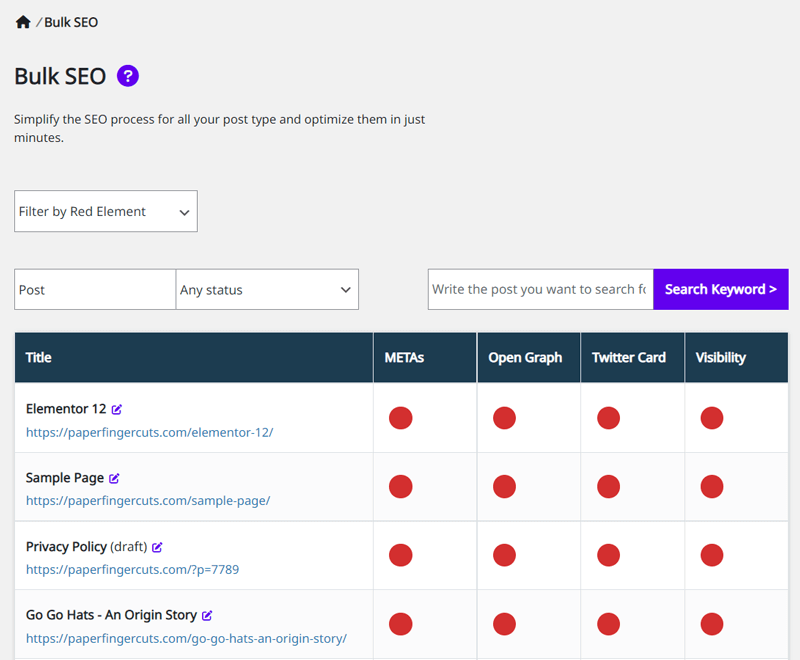Thin Content SEO – Why even bother thinking about it?

A few reasons come to mind:
- you will suffer Google ranking penalties
- thin content is useless for people searching for topics on search engines
- if you want searchable and branded content like “Squirrly SEO 2022 Launch Date”, then you as a company must make sure it’s not thin content. Don’t be lazy
- Thin Content Is Awesome! (your most avid readers will love it. Why do you think micro-blogging is still a thing?)
- thin content is useful (in our experience: our partners are super-excited to see all our Powering Up posts as a company)
- it’s also good for your feeds: your blog feeds AND your social media feeds. (hey you can grab people to such content and then re-target them with quora pixel, facebook pixel, etc.)
let’s be honest: we’ve been blogging since 2012 at the Squirrly Company.
You’d think that some of our older blog posts are just begging for a thin content SEO penalty!
We’re Squirrly. We have a very good way for dealing with it, and because we love you, we’re making it available to you, for the first time ever, even if you’re not part of our exclusive and invite-only community: DMSuperstars. (<< even though I’ve basically just extended an invitation via that special link)
In the lines that follow you’ll see:
- why we keep creating thin content
- how we keep it from being indexed by Google
- what you can do about it
- how you can craft your own strategy for dealing with thin content SEO
How Do We Handle Thin Content at Squirrly?
Thin content SEO penalties have been happening for quite a while now. According to Google algorithm updates, the penalty can be harsher or softer.
If you want to make sure you’ll never run into trouble, just use the Squirrly SEO plugin in WordPress and make your thin content invisible to Google!
1) In Bulk SEO Settings -> Select the pages you consider to be Thin Content.
Here’s what my Bulk SEO Settings panel looks like after I’ve done that.

You can see from the titles and the URLs that these pages are mostly gibberish.
They would provide no value to people searching on the Google search engine.
Therefore:
2) Make sure these Thin Content pages are set to RED Dot on their Visibility column
That means these pages are invisible to Google.
(technical: Google will listen to your guidelines and ignore those pages. These pages will not be considered at all when indexing and ranking your site.)
This makes us avoid any kind of thin content SEO penalty or issue.
As easy as that.
Now if you want to look deeper, this is exactly what we do:

3) No Index, No Follow, Remove from Sitemap
Why?
No Index: Hey, Google. Make sure you don’t index this page. It’s not to be found on search engines.
No Follow (Don’t pass Link Juice): Hey Google, keep all the SEO Authority of any page from my site linking to this page 100% INTACT. Don’t try to pass authority from those legit SEO pages to this piece of content.
Remove from Sitemap: Hey WordPress, let’s make sure that we generate a sitemap where this page doesn’t show. Since this is only useful for ephemeral feeds, it’s not worth adding to an evergreen sitemap. It won’t be useful soon.
Why We Keep Creating Thin Content
Because with Squirrly SEO we easily avoid any type of SEO problem that could appear! We do love our tech.
Some of the reasons have already been shortly highlighted above. However, we do this:
- because we can. Squirrly SEO has our backs.
- because we must. Our audience loves it.
If you’ve seen our Core Values, then you know that Excellent Customer Service is a must for us!
We take Service very seriously. Our purpose is to serve our audience.
You’ve always helped us grow. We’ve always helped you grow.
It must be the reason why we have people paying subscriptions without interruptions for 6 years (and going!). Read about that here in this thin piece of content.
Over 10 Years of running this company.
Our Journey was fueled by thin content. It helped us build a very personal, very intimate relationship with our audience. It’s like they were really part of our family. Just as we are whispering in their ear (via the SEO Live Assistant) while they’re typing their blog posts, they are reading our feeds and then voicing their opinions via our support channels.
We’ve always been open to communication. << It’s the #1 reason for our success. Listening to all the amazing feedback (don’t think the feedback was always good; dude: even, bad feedback is amazing. I talk about this at conferences) we could make Squirrly SEO evolve, we could push all of the boundaries, explore new horizons and reach new heights.
The fact that the Squirrly company keeps publishing all of these “Developer Updates” and “News about the Company” blog posts, our audience also opens up to us and becomes a hugely important part of our DNA.
There you have it. That’s why we keep publishing thin content.
Wait… There’s more to the story:
Even before Squirrly received the initial Angel Investment… before we had a product created.. our audience loved the content we were producing, even though it had no SEO value.
This has always been clear for us.
For a while, in our history, because Squirrly SEO didn’t have the capacity to do what I’ve just shown you in this article today, I had to go and manually delete (and make 301 re-directions) older posts that meant so much for our company.
It was good for SEO.
It was bad for:
- new employees (we couldn’t show them our previous awesome campaigns, to help them learn and love us)
- our biggest fans (we have fans trying to find all of the older content, to see how we were back in the day)
At that time, I didn’t really think we had such big fans. Turns out I was wrong.
It took me a lot of time to do content audits, to keep clear lists of changes made, to work with the “trash” functions and to redirect everything, so we don’t get no broken links.
Some of the posts were linked-to in some of our special emails, so we were now sending our audience to broken links.
We’ll never do that again.
We’ll keep pushing thin content. Because Squirrly SEO can handle everything awesomely now.
That’s what I decided. Little did I know that we would end up generating huge demand for our partnership programs by publishing this kind of content!
Thin Content FTW at Squirrly: More Partnerships for Us
For the win: people in our audience kept reading all that we wrote throughout this year and seeing how far we’ve come along and how many new products were being added to our line-up, they could no longer stand aside.
They had to team up with us and become partners.
Some became affiliates, the others became members of our Web Dev Kits programs.
This big win for our company would have never been possible if we just stopped publishing the kinds of content that our audience loved.
Just because someone tells you: “Don’t do thin content.” it doesn’t mean you have to listen. Not 100% anyway.
There are work-arounds. You need to figure out what’s good for your company.
I think I’ve already convinced you that for Squirrly thin content is super helpful.
We deal with it our own way.
And we keep our SEO-oriented pages and content away from our feeds-oriented content in the eyes of Google.
It’s a big help for our SEO Strategies. The squirrly.co website is not the only place where we apply this.
Your Own Strategy for this type of SEO
Now that you know the full story, it’s time for you to decide on your own strategy.
Will you go with the elegant Squirrly SEO way of dealing with such content?
Or will you ruthlessly delete content from your site (with the risk of doing many wrongs and wasting lots of time)?
You decide!
I just wanted to show you that there’s a really good way for you to handle thin content SEO.
If your company doesn’t usually communicate and stays away from public launches, public events, public comments, then you don’t even really need to create thin content as part of your communication strategy. In that case you don’t need to create such content.
However, keep in mind that you’ll still have to use a clever system to make certain URLs invisible on your site. In some cases attachment pages (not in all cases, though), in some cases some custom post types, or custom taxonomies. You can still have URLs that could be deemed thin content. It’s good to prepare a strategy for dealing with it.
Keep Ranking! (both on Search Engines, and in Blog and Social Media Feeds!)












